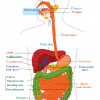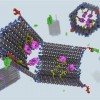Jumping Down the Road to Cancer.
Lying dormant in our genomes are millions of jumping genes. Originally discovered by Barbara McClintock, transposons are DNA sequences that can move from one location to another in our DNA. Transposons cause mutations when they jump to new locations, so keeping them from jumping is important. However, although transposons are largely silent, every person probably has a few “rare” sites, found in only a few people in the world, where a transposon has jumped to a new location.
Mutations in numerous pathways need to accumulate for cancer to progress. Given the ability of transposons to cause mutation and the role of mutation in cancer, it seemed likely that transposons would play a role in cancer. A few years ago, Iskow and colleagues showed that transposons jump in some lung tumors, suggesting a link to cancer progression. They also showed that methylation levels are often lower in lung cancers. Methylation is important for transposons silencing, so they hypothesized that lowered methylation in cancer could lead to more transposon jumps. This would “destabilize” the genome, allowing more mutations to accumulate, and accelerating cancer progression.
However, very little evidence of this connection existed until recently. With the advent of high-throughput sequencing, it is becoming possible to examine changes in the genomes of cancer cells. Lee and colleagues report on one such study. They decided to look at the effect of retrotransposons by comparing the location of these jumping genes in normal and cancer cells. Retrotransposons copy their sequence from one location to another by going through an RNA intermediate that is read “backwards” from RNA to DNA.
In their study, they had to overcome a problem: because transposons are found throughout the genome and are mostly the same in different individuals, it is hard to figure out exactly where new transposons are located. To sort this out, they developed a bioinformatics tool that could align sequence to a reference genome and identify new transposon sequence associated with this sequence. They then used normal tissue and cancer tissue from the same individual to identify transposition events in cancer cells.
Interestingly, different cancer types had different numbers of transposon jumps. Brain and blood cancers did not have many transposon-induced mutations, while epithelial cancers had frequent insertions. These jumping-gene insertions are probably important for cancer, as many of the insertions occur within genes known to affect cancer biology.
If these jumping genes cause mutations and promote cancer, why are they there? It’s still an area of contention, but all that jumping around helps provide diversity in our genomes. Sometimes that will prove to be bad, but it also allows natural selection to act on the diversity, allowing new, helpful innovations in our DNA power evolution.
Iskow el al, 2010. Natural mutagenesis of human genomes by endogenous retrotransposons. Cell. 141(7):1253-61.
Lee et. al, 2012. Landscape of Somatic Retrotransposition in Human Cancers. Science. 337(6097): 967-971.
| Print article | This entry was posted by Bruce Nash on August 28, 2012 at 11:21 am, and is filed under Inside Cancer. Follow any responses to this post through RSS 2.0. You can leave a response or trackback from your own site. |











